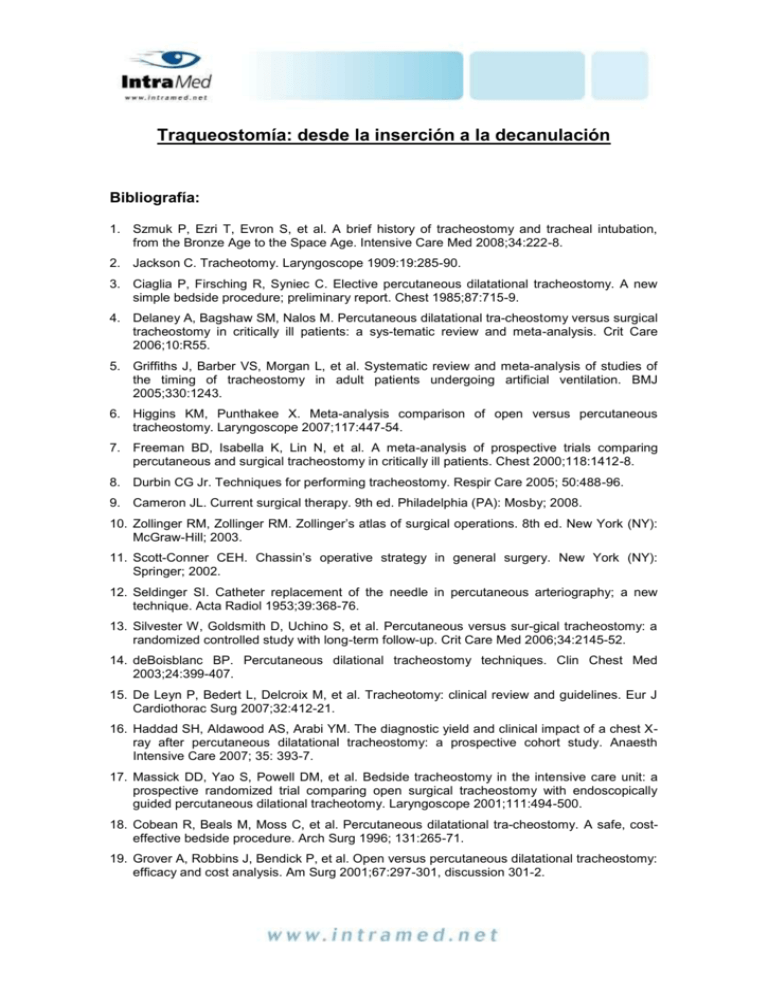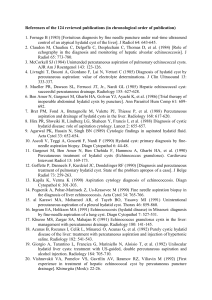Traqueostomía: desde la inserción a la decanulación
advertisement

Traqueostomía: desde la inserción a la decanulación Bibliografía: 1. Szmuk P, Ezri T, Evron S, et al. A brief history of tracheostomy and tracheal intubation, from the Bronze Age to the Space Age. Intensive Care Med 2008;34:222-8. 2. Jackson C. Tracheotomy. Laryngoscope 1909:19:285-90. 3. Ciaglia P, Firsching R, Syniec C. Elective percutaneous dilatational tracheostomy. A new simple bedside procedure; preliminary report. Chest 1985;87:715-9. 4. Delaney A, Bagshaw SM, Nalos M. Percutaneous dilatational tra-cheostomy versus surgical tracheostomy in critically ill patients: a sys-tematic review and meta-analysis. Crit Care 2006;10:R55. 5. Griffiths J, Barber VS, Morgan L, et al. Systematic review and meta-analysis of studies of the timing of tracheostomy in adult patients undergoing artificial ventilation. BMJ 2005;330:1243. 6. Higgins KM, Punthakee X. Meta-analysis comparison of open versus percutaneous tracheostomy. Laryngoscope 2007;117:447-54. 7. Freeman BD, Isabella K, Lin N, et al. A meta-analysis of prospective trials comparing percutaneous and surgical tracheostomy in critically ill patients. Chest 2000;118:1412-8. 8. Durbin CG Jr. Techniques for performing tracheostomy. Respir Care 2005; 50:488-96. 9. Cameron JL. Current surgical therapy. 9th ed. Philadelphia (PA): Mosby; 2008. 10. Zollinger RM, Zollinger RM. Zollinger’s atlas of surgical operations. 8th ed. New York (NY): McGraw-Hill; 2003. 11. Scott-Conner CEH. Chassin’s operative strategy in general surgery. New York (NY): Springer; 2002. 12. Seldinger SI. Catheter replacement of the needle in percutaneous arteriography; a new technique. Acta Radiol 1953;39:368-76. 13. Silvester W, Goldsmith D, Uchino S, et al. Percutaneous versus sur-gical tracheostomy: a randomized controlled study with long-term follow-up. Crit Care Med 2006;34:2145-52. 14. deBoisblanc BP. Percutaneous dilational tracheostomy techniques. Clin Chest Med 2003;24:399-407. 15. De Leyn P, Bedert L, Delcroix M, et al. Tracheotomy: clinical review and guidelines. Eur J Cardiothorac Surg 2007;32:412-21. 16. Haddad SH, Aldawood AS, Arabi YM. The diagnostic yield and clinical impact of a chest Xray after percutaneous dilatational tracheostomy: a prospective cohort study. Anaesth Intensive Care 2007; 35: 393-7. 17. Massick DD, Yao S, Powell DM, et al. Bedside tracheostomy in the intensive care unit: a prospective randomized trial comparing open surgical tracheostomy with endoscopically guided percutaneous dilational tracheotomy. Laryngoscope 2001;111:494-500. 18. Cobean R, Beals M, Moss C, et al. Percutaneous dilatational tra-cheostomy. A safe, costeffective bedside procedure. Arch Surg 1996; 131:265-71. 19. Grover A, Robbins J, Bendick P, et al. Open versus percutaneous dilatational tracheostomy: efficacy and cost analysis. Am Surg 2001;67:297-301, discussion 301-2. 20. Bacchetta MD, Girardi LN, Southard EJ, et al. Comparison of open versus bedside percutaneous dilatational tracheostomy in the cardio-thoracic surgical patient: outcomes and financial analysis. Ann Thorac Surg 2005;79:1879-85. 21. Oliver ER, Gist A, Gillespie MB. Percutaneous versus surgical tra-cheotomy: an updated meta-analysis. Laryngoscope 2007;117:1570-5. 22. Blankenship DR, Kulbersh BD, Gourin CG, et al. High-risk tra-cheostomy: exploring the limits of the percutaneous tracheostomy. Laryngoscope 2005;115:987-9. 23. Heyrosa MG, Melniczek DM, Rovito P, et al. Percutaneous tra-cheostomy: a safe procedure in the morbidly obese. J Am Coll Surg 2006; 202:618-22. 24. Plummer AL, Gracey DR. Consensus conference on artificial airways in patients receiving mechanical ventilation. Chest 1989;96:178-80. 25. Bouderka MA, Fakhir B, Bouaggad A, et al. Early tracheostomy versus prolonged endotracheal intubation in severe head injury. J Trauma 2004;57:251-4. 26. Rodriguez JL, Steinberg SM, Luchetti FA, et al. Early tracheostomy for primary airway management in the surgical critical care setting. Surgery 1990;108:655-9. 27. Rumbak MJ, Newton M, Truncale T, et al. A prospective, random-ized, study comparing early percutaneous dilational tracheotomy to prolonged translaryngeal intubation (delayed tracheotomy) in crit -ically ill medical patients. Crit Care Med 2004;32:1689-94. 28. Saffle JR, Morris SE, Edelman L. Early tracheostomy does not improve outcome in burn patients. J Burn Care Rehabil 2002;23:431-8. 29. Dunham CM, LaMonica C. Prolonged tracheal intubation in the trauma patient. J Trauma 1984;24:120-4. 30. Arabi Y, Haddad S, Shirawi N, et al. Early tracheostomy in intensive care trauma patients improves resource utilization: a cohort study and literature review. Crit Care 2004;8:R34752. 31. Dunham CM, Ransom KJ. Assessment of early tracheostomy in trauma patients: a systematic review and meta-analysis. Am Surg 2006; 72:276-81. 32. Dunn PF, Goulet RL. Endotracheal tubes and airway appliances. Int Anesthesiol Clin 2000;38:65-94. 33. Early percutaneous tracheostomy for cardiac surgery (ETOC). NCT00347321. Available: www .clinicaltrials .gov /ct2 /show /NCT 00347321?term =NCT00347321&rank =1 (accessed 2009 Aug. 11). 34. Efficacy of early tracheostomy to reduce incidence of ventilator acquired pneumonia (VAP). NCT00262431. Available: www .clinical trials .gov /ct2 /show /NCT00262431?term =NCT00262431 &rank =1 (accessed 2009 Aug. 11). 35. TracMan: tracheostomy management in critical www.tracman.org.uk (accessed 2009 Aug. 11). care [trial website]. Available: 36. Heffner JE. Tracheotomy application and timing. Clin Chest Med 2003;24:389-98. 37. Kane TD, Rodriguez JL, Luchette FA. Early versus late tra-cheostomy in the trauma patient. Respir Care Clin N Am 1997;3:1-20. 38. Trottier SJ, Hazard PB, Sakabu SA, et al. Posterior tracheal wall per-foration during percutaneous dilational tracheostomy: an investiga-tion into its mechanism and prevention. Chest 1999;115:1383-9. 39. Rogers ML, Nickalls RW, Brackenbury ET, et al. Airway fire during tracheostomy: prevention strategies for surgeons and anaesthetists. Ann R Coll Surg Engl 2001;83:37680. 40. Epstein SK. Late complications of tracheostomy. Respir Care 2005; 50:542-9. 41. Sue RD, Susanto I. Long-term complications of artificial airways. Clin Chest Med 2003;24:457-71. 42. Sviri S, Samie R, Roberts BL, et al. Long-term outcomes following percutaneous tracheostomy using the Griggs technique. Anaesth Intensive Care 2003;31:401-7. 43. Antonelli M, Michetti V, Di Palma A, et al. Percutaneous translaryn-geal versus surgical tracheostomy: a randomized trial with 1-yr double-blind follow-up. Crit Care Med 2005;33:1015-20. 44. Melloni G, Muttini S, Gallioli G, et al. Surgical tracheostomy versus percutaneous dilatational tracheostomy. A prospective-randomized study with long-term follow-up. J Cardiovasc Surg (Torino) 2002;43:113-21. 45. Ridley RW, Zwischenberger JB. Tracheoinnominate fistula: surgical management of an iatrogenic disaster. J Laryngol Otol 2006;120:676-80. 46. Gelman JJ, Aro M, Weiss SM. Tracheo-innominate artery fistula. J Am Coll Surg 1994;179:626-34. 47. Shen KR, Mathisen DJ. Management of persistent tracheal stoma. Chest Surg Clin N Am 2003;13:369-73. 48. Hess DR. Tracheostomy tubes and related appliances. Respir Care 2005; 50:497-510. 49. Loh KS, Irish JC. Traumatic complications of intubation and other airway management procedures. Anesthesiol Clin North America 2002; 20:953-69. 50. St John RE, Malen JF. Contemporary issues in adult tracheostomy management. Crit Care Nurs Clin North Am 2004;16:413-30. 51. Mirza S, Cameron DS. The tracheostomy tube change: a review of techniques. Hosp Med 2001;62:158-63. 52. Schein M. Aphorisms and quotations for the surgeon. Worchester (UK): Trinity Press; 2003.
